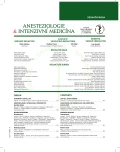Pulmonary trauma by energy load – ventilator-induced lung injury
Authors:
J. Máca 1,2; F. Burša 1,2
Authors‘ workplace:
Klinika anesteziologie, resuscitace a intenzivní medicíny, Fakultní nemocnice Ostrava
1; Katedra intenzivní medicíny, urgentní medicíny a forenzních oborů, Lékařská fakulta, Ostravská univerzita
2
Published in:
Anest. intenziv. Med., 28, 2017, č. 3, s. 163-167
Category:
Intensive Care Medicine - Review Article
Overview
Ventilator-induced lung injury (VILI) is a serious medical condition related to the use of injurious mechanical ventilation (MV). Recent literature outlines a novel perspective on the development of VILI - the mechanical power concept, unifying the static and dynamic variables of MV in relation to the energy load of the respiratory system and VILI. The aim of the text is a brief characteristic of the concept in relation to the recent literature.
Keywords:
ventilator-induced lung injury – mechanical power – mechanical ventilation
Sources
1. Plötz FB, Slutsky AS. Ventilator-induced lung injury and multiple system organ failure: a critical review of facts and hypotheses. Intensive Care Med 2004;30:1865–1872.
2. Maron-Gutierrez T, Pelosi P, Rocco PRM. Ventilator-induced lung injury, New Developments in Mechanical Ventilation, Eur Respir Mon. Monographs 2012;55:1–18.
3. Neto AS, Jaber S. What’s new in mechanical ventilation in patients without ARDS : lessons from the ARDS literature. Intensive Care Med 2016;42:5–7.
4. Gattinoni L, Quintel M. How ARDS should be treated. Crit Care 2016;20(1):86.
5. Slutsky AS, Ranieri VM. Ventilator-Induced Lung Injury. N Engl J Med 2013;369:2126–2136.
6. West JB. Cellular Responses to Mechanical Stress Invited Review: Pulmonary capillary stress failure. J Appl Physiol 2000;89:2483–2489.
7. Raghavendran K, Willson D, Notter R. Surfactant Therapy of ALI and ARDS. Crit Care Clin 2011;27:525–559.
8. Gattinoni L, Tonetti T, Cressoni M, et al. Ventilator-related causes of lung injury: the mechanical power. Intensive Care Med 2016;42:1567–1575.
9. Cressoni M, Cadringher P, Chiurazzi C, et al. Lung Inhomogeneity in Patients with Acute Respiratory Distress Syndrome. Am J Respir Crit Care Med 2014;189(2):149–158.
10. Sheppard D. Functions of Pulmonary Epithelial Integrins: From Development to Disease. Physiol Rev 2003;83:673–686.
11. Nieman GF, Satalin J, Andrews P, et al. Lung stress, strain, and energy load: engineering concepts to understand the mechanism of ventilator-induced lung injury (VILI). Intensive Care Med Exp. 2016;4:16.
12. Protti A, Andreis DT, Milesi M, et al. Lung anatomy, energy load, and ventilator-induced lung injury. Intensive Care Med Exp. 2015;3:34.
13. Cressoni M, Gotti M, Chiurazzi C, et al. Mechanical Power and Development of Ventilator-induced Lung Injury. Anesthesiology. 2016;124:1100–1108.
14. Kenny JES, 2016. ICU Physiology in 1,000 Words: ARDS – Part 1. http://pulmccm.org/main/2016/ards-review/icu-physiology-1000-words-ards-part-1/.
15. Ventilation with lower tidal volumes as compared with traditional tidal volumes for acute lung injury and the acute respiratory distress syndrome. The Acute Respiratory Distress Syndrome Network. N Engl J Med. 2000;342:1301–1308.
16. Brower R, Lanken P, MacIntyre N, et al. Higher versus Lower Positive End-Expiratory Pressures in Patients with the Acute Respiratory Distress Syndrome. N Engl J Med. 2004;351:327–336.
17. Ferguson N, Cook D, Guyatt H, et al. High-frequency oscillation in early acute respiratory distress syndrome. N Engl J Med. 2013;368:795–805.
18. Young D, Lamb S, Shah S, et al. High-Frequency Oscillation for Acute Respiratory Distress Syndrome. N Engl J Med. 2013;368:806–813.
Labels
Anaesthesiology, Resuscitation and Inten Intensive Care MedicineArticle was published in
Anaesthesiology and Intensive Care Medicine

2017 Issue 3
Most read in this issue
- Epidemiology of out-of-hospital cardiac arrest in the Czech Republic – national results of the EuReCa ONE trial
- Pulmonary trauma by energy load – ventilator-induced lung injury
- Healthcare associated pneumonia in intensive care patients – optimal choice of initial empirical antimicrobial therapy: Results of a multicenter, observational study
- Practical application of the results of clinical trials
